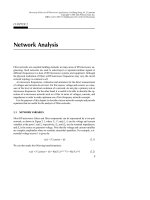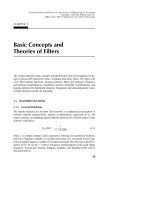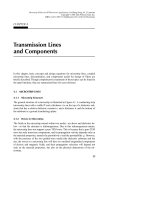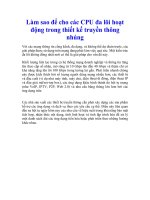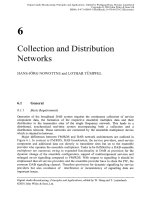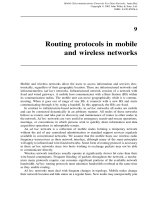Tài liệu Microstrip bộ lọc cho các ứng dụng lò vi sóng RF (P12) pptx
Bạn đang xem bản rút gọn của tài liệu. Xem và tải ngay bản đầy đủ của tài liệu tại đây (915.73 KB, 25 trang )
CHAPTER 12
Case Study for Mobile
Communications Applications
Microstrip filters play various roles in wireless or mobile communication systems.
This chapter is particularly concerned with a case study of high-temperature super-
conducting (HTS) microstrip filters for the cellular base station applications. The
study starts with a brief discussion of typical HTS subsystems and RF modules, in-
cluding HTS microstrip filters for cellular base stations. This is followed by more
detailed descriptions of the developments of duplexers and preselect bandpass fil-
ters, including design, fabrication, and measurement. The work presented here has
been carried out mainly for a European research project called Superconducting
Systems for Communications (SUCOMS), in which the authors have been involved.
The project is funded through the Advanced Communications Technologies and
Services (ACTS) program. It involved a number of companies (GEC-Marconi, UK;
Thomson-CSF, France; and Leybold, Germany), the University of Birmingham,
UK, and the University of Wuppertal, Germany. The objective of the project was to
construct an HTS-based transceiver for mast-mounted DCS1800 base stations.
12.1 HTS SUBSYSTEMS AND RF MODULES FOR
MOBILE BASE STATIONS
The technology and system challenges of next generation mobile communications
have stimulated considerable interest in applications of high-temperature supercon-
ducting (HTS) technology [1–7]. The challenges for cellular mobile base stations
vary but may focus on increasing sensitivity and selectivity:
ț Sensitivity—The benefits of increasing sensitivity in rural areas is obvious
since the number of mobile base stations and thus the investment necessary to
secure the radio coverage of a given area will be reduced as the range of each
433
Microstrip Filters for RF/Microwave Applications. Jia-Sheng Hong, M. J. Lancaster
Copyright © 2001 John Wiley & Sons, Inc.
ISBNs: 0-471-38877-7 (Hardback); 0-471-22161-9 (Electronic)
mobile base station is increased. Increasing sensitivity is also desirable in ur-
ban co-channel, interference-limited areas since it allows the mobile termi-
nals to reduce the average radiated power and increase their autonomy.
ț Selectivity—The soaring demand for mobile communications place severe
demands on frequency resources as the allocated bandwidth becomes increas-
ingly congested. Interference is a growing, pervasive threat to the mobile
communication industry, particularly in dense urban regions. Increasing se-
lectivity to improve interference rejection will increase call clarity and reduce
the number of dropped calls, which will lead to a general improvement in the
Quality of Service (QoS).
For these and other requirements, a mobile base station receiver subsystem that in-
cludes HTS microstrip filters has been developed by SUCOMS. Figure 12.1 shows
a block diagram of one typical sector of the HTS subsystem. For coverage, the mo-
bile base station is actually comprised of the three identical sectors. As shown in
Figure 12.1, each of them is equipped with a transmit/receive antenna and a receive-
only antenna for diversity purposes. The HTS duplexers, preselect filters, and low-
noise amplifiers (LNAs) are tower-mounted on the top of the antenna mast of the
434
CASE STUDY FOR MOBILE COMMUNICATIONS APPLICATIONS
HTS Duplexer
HTS
Bandpass
Filters
HTS
Bandpass
Filters
LNA
LNA
Main
Antenna
Diversity
Antenna
Tower-mounted unit
Indoor Racks
FIGURE 12.1 Typical mobile communication base station sector using HTS subsystem.
base station, whereas the transmit combiners and receive splitters are located in the
shelter at the bottom of the tower of the base station. This subsystem is much the
same as a conventional one, except that the duplexers and preselect bandpass filters
are made using HTS thin film microstrip components. The use of the HTS compo-
nents enables increases in both the sensitivity and selectivity due to extremely low
losses in the materials (see Chapter 7 for details). The subsystem developed is for a
Digital Communication System or DCS-1800 base station, but can be interfaced
with a Global System for Mobile Communication System or GSM-1800 base sta-
tion. It can also be modified for other mobile communication systems such as the
Personal Communication System (PCS) and the future Universal Mobile Telecom-
munication System (UMTS).
The RF components shown in the tower-mounted unit of Figure 12.1 are operat-
ed at a low temperature in a vacuum cooler. This is necessary for the HTS compo-
nents, but the LNAs are also cooled, which gives the system an extra reduction in
overall noise figure. It has been reported [7] that the noise figure of a LNA is re-
duced from a room temperature figure of <0.8 dB to <0.2 dB at 77 K. Design of the
RF components, the vacuum encapsulation, the RF modules, and cryo-cooler are in-
separably linked. The RF components are housed in common modules. This ap-
proach allows the transmitter and receiver functions to be developed in parallel. It
further allows the complete system to be progressively developed and field trailed.
Figure 12.2 illustrates a dual-sided, six-channel HTS microstrip filter/LNA module,
where only three channels can be seen; the other three-channels are on the other
side of the RF module. The RF module for three channel HTS microstrip duplexers
is shown in Figure 12.3. The diameter of the RF modules is only about 150 mm. The
designs and performances of the HTS microstrip filters and duplexers are fully de-
scribed in the next two sections. For the vacuum encapsulation, the cryogenic/RF
interconnection across the encapsulation vacuum space may be accomplished using
high thermal resistance RF coaxial cables. In this design, a nonsuperconductor mi-
crostrip feed network inside a connector ring and a novel RF/thermal link were used
to achieve a low conduction heat load. The RF signals fed through K-connectors
mounted on the wall of the connector ring are propagated from the ambient temper-
ature side to the cold side through short, thin bondwires.
In designing a tower-mounted transceiver based on HTS technology, it is desir-
able to make the cooler that is required to cool the HTS components and LNAs “in-
visible” to the base station operator. The cooler must be compact, low mass, self-
contained, have minimal service utilities, and be highly reliable. A commercially
available Stirling cycle cooler has been used for this purpose. Figure 12.4 shows a
demonstration comprising the encapsulated RF modules assembled on a Stirling
cooler with dual cold finger and dual compressor. The dual balanced compressor
and cold head can reduce the vibration levels to a minimum. The cooler provides a
heat lift of >4 W at 60 K, which easily meets the cooling requirements for the HTS
microstrip duplexers, preselect filters, and LNAs in the RF modules. There are oth-
er types of coolers, such as Gifford McMahon coolers and pulse tube coolers which
may also be used. Figure 12.5 demonstrates a prototype of the entire tower-mounted
unit with a weatherproof enclosure opened on the side. The prototype consists of the
12.1 HTS SUBSYSTEMS AND RF MODULES FOR MOBILE BASE STATIONS
435
encapsulated RF modules on the cooler, temperature control loop, and power sup-
plies. Lightning protection, alarms, and bypass relays are also included. This mobile
base station tower-mounted unit is 650 mm ×550 mm ×300 mm with an associated
mass of 37 Kg.
12.2 HTS MICROSTRIP DUPLEXERS
As above discussed, the HTS microstrip duplexers and bandpass filters are essential
RF components in the RF modules for the tower-mounted transceiver developed for
mobile base station applications. The design and performance of the HTS mi-
crostrip duplexers are described first in this section. The HTS-based transceiver is
for the DCS–1800 standard, which covers a receive (Rx) band from 1710 to 1785
MHz, and a transmit (Tx) band from 1805 to 1880 MHz. The function of each du-
plexer is twofold: 1) to route the received signal from the antenna to the receiver
436
CASE STUDY FOR MOBILE COMMUNICATIONS APPLICATIONS
HTS Microstrip
Bandpass Filter
Non-HTS
Microstrip
Circuit
LNA
FIGURE 12.2 RF module with dual-sided six channels of HTS microstrip filters and LNAs.
HTS Microstrip
Duplexer
Non-HTS
Microstrip
Circuit
FIGURE 12.3 RF module with three channels of HTS microstrip duplexers.
Compressor
Encapsulated
RF Modules
FIGURE 12.4 Encapsulated RF modules on the Stirling cooler with dual cold head and dual compres-
sor.
437
preselect filter that covers a 15 MHz subband of the Rx band, and 2) to route the
high-power Tx signal from the Tx channel to the antenna, which must be accom-
plished without any significant amount of power from the Tx signal being incident
upon the Rx filter (good isolation between Tx and Rx). The result is that one anten-
na can be used for both Tx and Rx functions.
12.2.1 Duplexer Principle
The duplexer developed consists of two –3 dB hybrids and two bandstop filters con-
nected as in Figure 12.6. Assume that port 1 of hybrid A is the Tx port; ports 2 and 3
of hybrid B are then the Rx and antenna ports, respectively. The operation principle
of the duplexer is described below.
For our purposes, let us assume that the hybrids are ideal, represented by a scat-
tering matrix:
[S]
H
=
΄΅
(12.1)
Consider hybrid B on the right-hand side of Figure 12.6. Its ports 1 and 4 can be ter-
minated by the two loads with reflection coefficients of ⌫
1
and ⌫
4
, which, as a mat-
0
–1/
͙
2
ෆ
–j1/
͙
2
ෆ
0
–1/
͙
2
ෆ
0
0
–j1/
͙
2
ෆ
–j1/
͙
2
ෆ
0
0
–1/
͙
2
ෆ
0
–j1/
͙
2
ෆ
–1/
͙
2
ෆ
0
438
CASE STUDY FOR MOBILE COMMUNICATIONS APPLICATIONS
FIGURE 12.5 Tower-mounted transceiver with HTS microstrip duplexers and filters for mobile base
station application.
FIGURE 12.6 Schematic diagram of the duplexer to be designed.
ter of fact, are the reflection coefficients of the two bandstop filters, respectively. It
can be shown that the resultant two-port network is written as
ᎏ
1
2
ᎏ
(⌫
4
– ⌫
1
)
ᎏ
2
j
ᎏ
(⌫
1
+ ⌫
4
)
΄΅
=
΄΅
·
΄΅
(12.2)
ᎏ
2
j
ᎏ
(⌫
1
+ ⌫
4
)
ᎏ
1
2
ᎏ
(⌫
1
– ⌫
4
)
where a and b denote the incident and reflected wave variables. If ⌫
1
= ⌫
4
= ⌫, the
transmission from the antenna port to the receiver port is given by
S
Antenna–Rx
= = j⌫ (12.3)
Now it is clear that if |⌫| = 1 the received signal at the antenna port will be diverted
into the receiver port without any loss. The first condition for ⌫
1
= ⌫
4
requires two
identical bandstop filters. The second condition for |⌫| = 1 requires the bandstop fil-
ters to have not only high rejection at the receive band frequencies, but also very
low loss in the reflected signal. This necessities the use of a superconductor because
of its low conductor loss, particularly if the circuits are to be miniaturized.
Next, let us assume that the bandstop filters have no attenuation at the transmit
band, so that they may be treated as two ideal phase shifters with a phase constant of
. If a transmitting signal represented by a
1A
inputs at the transmitter port, it can be
shown that
S
Tx–Rx
=
ᎏ
b
a
2
1
B
A
ᎏ
= (S
21
·S
21
+ S
24
·S
31
)·e
–j
(12.4)
S
Tx–Antenna
=
ᎏ
b
a
3
1
B
A
ᎏ
= (S
31
·S
21
+ S
34
·S
31
)·e
–j
Substituting the S parameters of the ideal hybrid from (12.1) into (12.4) gives
S
Tx–Rx
= 0
(12.5)
S
Tx–Antenna
= e
–j(
–
/2)
Therefore, the signal from the transmitter port is totally diverted to the antenna port,
and there is an ideal isolation between the transmitter and receiver ports. One might
notice that to arrive at (12.5), the phase
is not necessarily constant over the entire
transmit band.
12.2.2 Duplexer Design
As a starting point for the design, a LAO substrate (refer to Chapter 7) was chosen
in order to reduce the size of the duplexer module for encapsulation with the other
b
2B
ᎏ
a
3B
a
2B
a
3B
b
2B
b
3B
12.2 HTS MICROSTRIP DUPLEXERS
439
components in the tower-mounted unit of Figure 12.1. In considering the required
overall power handling (12 W) of the transmit channel, it was also decided to design
and fabricate HTS hybrids. Because there are no resonant elements at the Tx band,
the power handling capability of the transmission line is more than adequate. The
designs of the HTS hybrid and bandstop filter are described next.
A. Microstrip Hybrids
The simplest –3 dB hybrid would be the branch line coupler [15–17]. However, it
provides very little design margin due to its limited bandwidth. Therefore, it was
chosen to use tandem couplers [18]. A tandem arrangement of two coupled-line di-
rectional couplers shown in Figure 12.7 results in a wider bandwidth, which can im-
prove the overall performance of the duplexer. Besides, the tandem coupler has a
smaller size. The tandem connection entails two line crossings, which may be real-
ized using bondwire bridges. The operation principle of the tandem coupler is de-
scribed as referring to Figure 12.7, where a and b represent the incident and reflect-
ed wave variables, respectively. The coupling and transmission are defined by
jc·e
j
= = =
(12.6)
t·e
j
=
ᎏ
b
a
4
1
ᎏ
= =
where c and t denotes the scaled coupling and transmission coefficients, and
is a
reference phase. Note that the coupling is 90° out of phase of the transmission. For
simplicity, a reference phase
= 0 will be assumed, which does not affect the out-
come. Let the input at port 1 be a
1
, then the outputs at ports 3Ј and 4Ј can be found
to be
b
3Ј
= ta
2Ј
+ jca
1Ј
= (t
2
– c
2
)a
1
b
4Ј
= jca
2Ј
+ ta
1Ј
= j2cta
1
b
3Ј
ᎏ
a
2Ј
b
4Ј
ᎏ
a
1Ј
b
4Ј
ᎏ
a
2Ј
b
3Ј
ᎏ
a
1Ј
b
3
ᎏ
a
1
440
CASE STUDY FOR MOBILE COMMUNICATIONS APPLICATIONS
1
1’
3
3’
2
2’
4
4’
a
1
b
3
b
3’
a
1’
b
4
b
4’
a
2’
FIGURE 12.7 Tandem coupler formed by cascading two ideal directional couplers.
Thus, the transmissions from port 1 to ports 3Ј and 4Ј are given by
S
3Ј1
=
ᎏ
b
a
3
1
Ј
ᎏ
= t
2
– c
2
(12.7)
S
4Ј1
=
ᎏ
b
a
4
1
Ј
ᎏ
= j2ct
Notice that there is always a 90° phase difference between the two outputs regard-
less of their magnitudes. The equal magnitude of the two outputs can be achieved
using the condition
t
2
– c
2
= 2ct = (12.8)
Solving the equations yields
c = 0.3827 = –8.34 dB (12.9)
Hence, what is needed for a –3 dB tandem coupler is to design a pair of –8.34 dB
directional couplers. For quarter-wavelength coupled microstrip line realization, the
design equations are
Z
0e
= Z
0
Ί
ᎏ
1
1
+
–
c
c
ᎏ
(12.10)
Z
0o
= Z
0
Ί
ᎏ
1
1
+
–
c
c
ᎏ
where Z
0e
and Z
0o
are the even- and odd-mode impedance. Z
0
is the matching im-
pedance at the ports, and is equal to 50 ohms in our design. The design of the HTS
hybrid on a 0.5 mm thick LAO substrate was done with the aid of a full-wave elec-
tromagnetic (EM) simulator [19]. Shown in Figure 12.8(a) is the layout of the hy-
brid for the full-wave EM simulation, where the crosses indicate the line crossings
and all the coupled microstrip lines have a width of 0.128 mm. The EM simulated
frequency response is shown in Figure 12.8(b).
B. Microstrip Bandstop Filters
The specifications for the required bandstop filters are
Stopband frequencies 1770–1785 MHz
Minimum stopband attenuation 20 dB
Passband frequencies 1805–1880 MHz
Passband ripple 0.1 dB
1
ᎏ
͙
2
ෆ
12.2 HTS MICROSTRIP DUPLEXERS
441
442
CASE STUDY FOR MOBILE COMMUNICATIONS APPLICATIONS
0.128 mm
4.736 mm
PORT 1
PORT 2
PORT 3
PORT 4
11.352 mm
(a)
(b)
FIGURE 12.8 (a) Layout of HTS microstrip hybrid using tandem couplers on a 0.5 mm thick LAO
substrate. (b) Full-wave simulated performance of the hybrid.

